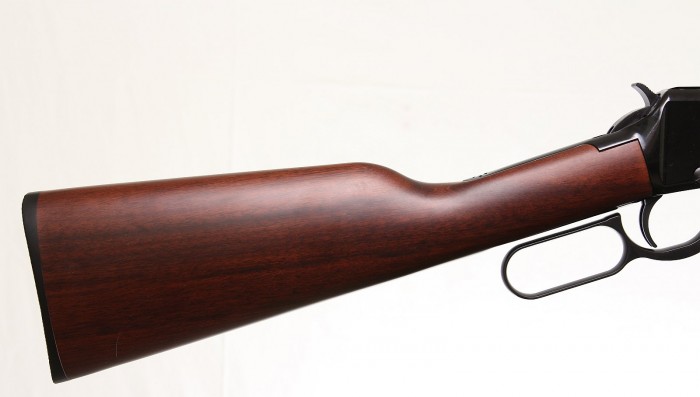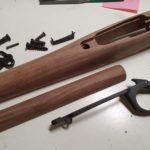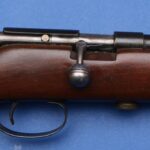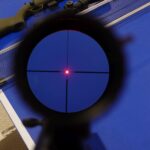
Why a Lever Action .22?
Henry rifles were recently on sale here in Canada, so I’ve got 2 to review: the Henry Lever Action 22, and the Henry US Survival Rifle. Interestingly enough, on-sale they were around the same price. But where the US Survival rifle was compact, semi-automatic, magazine-fed, and could float, the Henry Lever Action came with nice wood, a smooth action, and was a lot nicer on the eyes. That all said, an accurate bolt action .22 can be had for around $250 while fast-shooting, semi-automatic 22’s are right around the same price point. So why get a Henry lever-action? The Henry lever action 22 starts at around $449 in Canada and $299 in the US.

A Classic Look and Feel
I imagine that before semi-automatic rimfire rifles were as reliable, easy to clean, and inexpensive as they are now, that lever action rifles would have been the fast firing choice of their time. Most lever action 22’s that I’ve fired have been very fast and reliable, and those long magazine tubes hold enough ammo to last you a while on the gopher field. With a look similar to dad’s 30-30, they also would have been popular with boys who wanted to hunt small game with a rifle like dad had. Unlike many of the rifles these days, the Henry Lever comes with half decent walnut furniture instead of a plastic stock. So, it’s really aiming at a different segment than people purely concerned about either rimfire rifle accuracy or speed of shooting: it’s a mid-low cost ($250-$300), traditionally-styled 22.
Features: Simplicity
Unless you read the marketing literature, you won’t find many cool features on the rifle, but I think there’s some charm in that. There’s the multi-groove barrel, a hooded front sight and rear half circle sights, the receiver has 3/8 dovetail grooves for rimfire scope mounting, and the hammer has a very low half-cock position as a safety, but that’s about it. One of the cooler things that you can do with this rifle that you can’t with most semi-auto’s is run .22 shorts, 22 longs, and/or 22LR’s. With 22 shorts, you could fit more bullets in (21 to be exact), but given that the cost and performance with 22LR is pretty damn good, I can’t see why you’d bother.
Quality, With Some Compromises
Given the price point, there would have to be some modernization to the traditional construction of the rifle. Personally, I think the tradeoffs were in the rights spots.
For the price, I think that the wood, action, reliability, and solidness were all very good. Henry compromised with a painted aluminum receiver (rather than blued steel), some plastic and inexpensively cast parts here and there, but I can look past those for the price point and weight. The forend was also a bit loose, but after adjusting the barrel band just a bit, it stopped wobbling. Keep in mind that if you’re looking for all blued steel and wood and no plastic or cast parts, you’ll have to increase your budget or order the replacement parts where available. Henry sells metal barrel bands and metal front sights if you’re picky about these things.
In Use: No Surprises
Shooting the rifle, you’ll notice a few things:
- It just works.
- The trigger is pretty damn good (right around 5-7 lbs, very little creep, but a lot of overtravel)
- The lever is very smooth in operation. You barely feel like you’re doing anything.
- Loading 15 rounds in a magazine tube sucks. You don’t get your fingers chewed up like you do on some 22 magazines, but it takes forever and it’s somewhat awkward.
- Given the small ejection port, it can be a bit difficult to see if there’s a round ready to be loaded.
- The lever was too small to fit all my fingers in. It’s more of a 3 finger affair. If that bothers you, get the Carbine model with enlarged loop.
Beyond that, I found that the stock was best suited to the iron sights because it was too low to get a decent cheek weld when even a low profile scope was mounted. The stock on the Henry Golden Boy is even more hilariously low, so definitely don’t get one of those and then put a scope on it.
I also had a chance to test it in some extremely cold temperatures (-30 Celsius, or -22 Farenheit) and while it fed great, it did fail to light off a few rounds because of weak primer strikes. Frigid temperatures can really slow down the firing pin on a 22 unless you get absolutely ALL of the oil out of that channel.
Video Review
A Foregone Conclusion?
Are you in the market for a $200-$400, traditionally-styled, made in the US 22 rifle and don’t mind a few minor compromises here or there? Check out the Henry Classic Lever Action 22! There aren’t really many competitors these days. There’s the higher-priced Browning BL-22, which has nicer materials but not as smooth of an action (in my opinion), and then there’s the Mossberg 464 22LR but I think they only have the weird plastic zombie version now. So that leaves you with 2 effective makers if you’re in the market for a traditional lever-action 22. You won’t be buying based on performance or innovative features, but quality and craftsmanship. So when you’re at the gun store, take a look a the Henry, take a look at the Browning, take a look at your wallet, and make a choice.


















